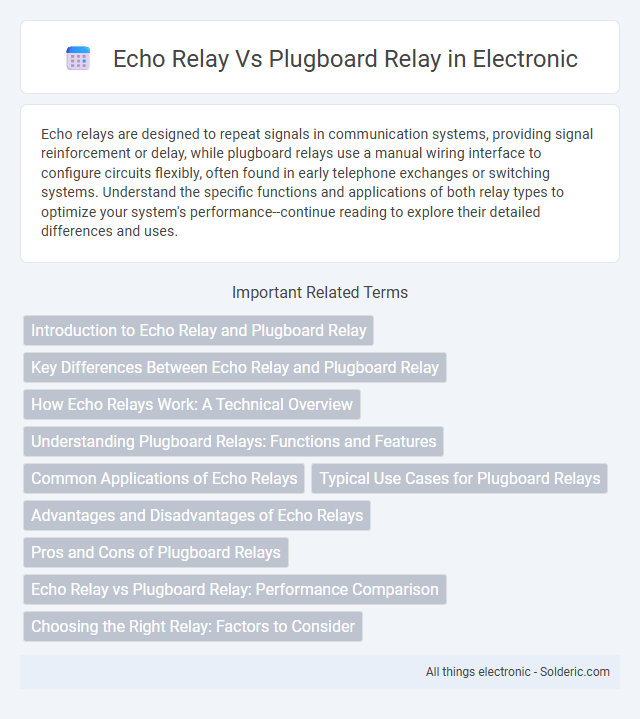Echo relays are designed to repeat signals in communication systems, providing signal reinforcement or delay, while plugboard relays use a manual wiring interface to configure circuits flexibly, often found in early telephone exchanges or switching systems. Understand the specific functions and applications of both relay types to optimize your system's performance--continue reading to explore their detailed differences and uses.
Comparison Table
| Feature | Echo Relay | Plugboard Relay |
|---|---|---|
| Primary Function | Amplifies and retransmits signals with delay | Manually switches circuits via plug connections |
| Operation | Automatically repeats signals (echo) | Manual patching for circuit routing |
| Use Case | Signal testing, debugging, and network delay simulation | Telephone switchboards and early computing systems |
| Signal Processing | Active signal regeneration with delay | Passive path selection without signal alteration |
| Complexity | Moderate | Simple |
| Control | Automated or remote-controlled | Manual plug-in configuration |
Introduction to Echo Relay and Plugboard Relay
Echo relays are electromechanical switches used to reproduce audio signals with minimal distortion, primarily found in telecommunications for signal processing tasks; they operate by echoing an input signal in synchronization with a control pulse. Plugboard relays, also known as crossbar or matrix relays, are wired manually or electronically to create customized circuit connections for routing signals in early telephone exchanges and computing machines. Both relay types serve crucial roles in historic telecommunication infrastructure but differ significantly in their design, purpose, and application within signal handling and switching systems.
Key Differences Between Echo Relay and Plugboard Relay
Echo relays operate by returning a signal to the sender to confirm reception, ensuring reliable communication feedback, whereas plugboard relays rely on physical wiring changes to route signals through specific circuits. Echo relays typically enable dynamic signal verification, enhancing fault detection, while plugboard relays require manual reconfiguration for different operations, limiting flexibility. Your choice depends on whether automated confirmation or customizable circuit control is more critical for your system's performance.
How Echo Relays Work: A Technical Overview
Echo relays operate by receiving an input signal and immediately retransmitting a replicated version of that signal to the output circuit, utilizing electromagnetic coils to create a magnetic field that closes the contacts without physical movement, ensuring faster switching times compared to traditional plugboard relays. These relays rely on precise amplification and signal feedback mechanisms to maintain signal integrity, making them ideal for high-speed communication systems. Their design minimizes contact wear and reduces electromagnetic interference, optimizing performance in telecommunication networks and automated switching systems.
Understanding Plugboard Relays: Functions and Features
Plugboard relays serve as crucial components in early computing and telecommunications, enabling programmable control by routing electrical signals based on physical plug connections. Unlike echo relays, which primarily retransmit signals for amplification or delay, plugboard relays facilitate customized circuit configurations, allowing dynamic adjustments and complex logical operations. Their flexible design supports multiple input-output pathways, making them instrumental in manual programming and switching systems before the advent of digital logic circuits.
Common Applications of Echo Relays
Echo relays are predominantly used in telecommunications for signal amplification and echo cancellation, enhancing voice clarity during long-distance calls. They find common applications in telephone exchanges and conference systems where minimizing signal delay and feedback is critical. Your communication networks benefit from echo relays by maintaining high-quality audio transmission in complex switching environments.
Typical Use Cases for Plugboard Relays
Plugboard relays are commonly used in applications requiring complex logic control and flexible circuit configurations, such as telecommunications switching systems and industrial automation. They enable easy reprogramming for varying circuit paths, making them ideal for prototyping and environments with frequently changing operational needs. Your systems can benefit from plugboard relays when you need versatile and reliable control solutions without extensive rewiring.
Advantages and Disadvantages of Echo Relays
Echo relays offer the advantage of faster signal processing and reduced noise interference compared to plugboard relays, making them ideal for high-speed communication systems. However, echo relays can be more complex to design and maintain, resulting in higher costs and increased technical expertise requirements. While plugboard relays provide simpler configuration and greater reliability in basic applications, echo relays excel in environments demanding enhanced signal clarity and rapid response times.
Pros and Cons of Plugboard Relays
Plugboard relays offer flexibility in configuring circuits through manual wiring, making them ideal for custom and experimental setups where rapid reconfiguration is needed. However, their complexity and susceptibility to human error during manual connections can lead to reliability issues and increased maintenance. You may find echo relays more straightforward for standardized applications, but plugboard relays excel in adaptability despite their potential for higher operational complexity.
Echo Relay vs Plugboard Relay: Performance Comparison
Echo relays offer faster switching speeds and higher reliability compared to plugboard relays, which rely on mechanical contact points prone to wear and slower response times. Plugboard relays provide greater flexibility in wiring configurations but typically suffer from increased signal latency and maintenance requirements. Your choice between echo relay and plugboard relay should consider the performance demands of the application, with echo relays favored for high-speed, high-precision needs.
Choosing the Right Relay: Factors to Consider
Choosing the right relay involves evaluating factors such as signal integrity, frequency response, and switching speed, where echo relays excel in minimizing signal distortion and are ideal for high-frequency applications. Plugboard relays offer flexibility and customization for complex circuit configurations but may introduce latency and signal degradation in sensitive systems. Prioritizing the relay type based on specific electrical performance requirements and application context ensures optimal system reliability and efficiency.
echo relay vs plugboard relay Infographic

 solderic.com
solderic.com